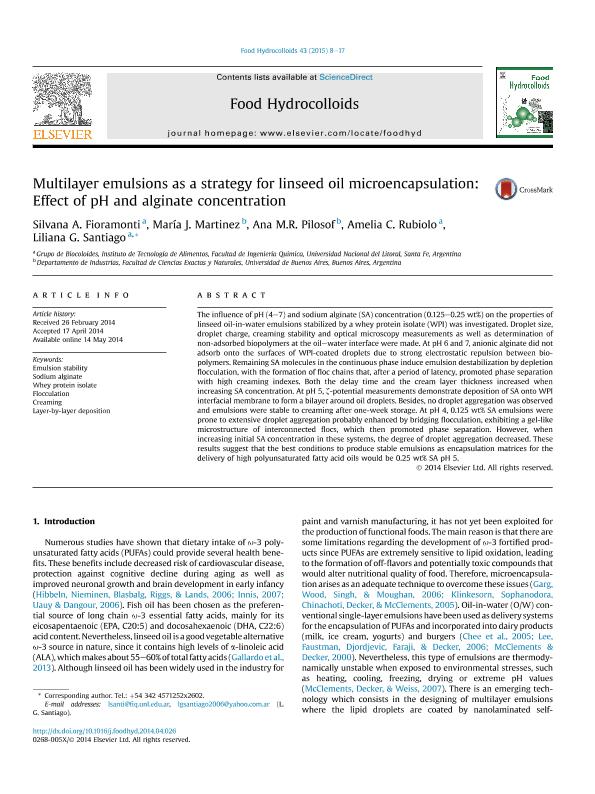Mostrar el registro sencillo del ítem
dc.contributor.author
Fioramonti, Silvana Alejandra

dc.contributor.author
Martinez, María Julia

dc.contributor.author
Pilosof, Ana Maria Renata

dc.contributor.author
Rubiolo, Amelia Catalina

dc.contributor.author
Santiago, Liliana Gabriela

dc.date.available
2018-03-09T17:42:24Z
dc.date.issued
2015-01
dc.identifier.citation
Fioramonti, Silvana Alejandra; Martinez, María Julia; Pilosof, Ana Maria Renata; Rubiolo, Amelia Catalina; Santiago, Liliana Gabriela; Multilayer emulsions as a strategy for linseed oil microencapsulation: Effect of pH and alginate concentration; Elsevier; Food Hydrocolloids; 43; 1-2015; 8-17
dc.identifier.issn
0268-005X
dc.identifier.uri
http://hdl.handle.net/11336/38410
dc.description.abstract
The influence of pH (4-7) and sodium alginate (SA) concentration (0.125-0.25wt%) on the properties of linseed oil-in-water emulsions stabilized by a whey protein isolate (WPI) was investigated. Droplet size, droplet charge, creaming stability and optical microscopy measurements as well as determination of non-adsorbed biopolymers at the oil-water interface were made. At pH 6 and 7, anionic alginate did not adsorb onto the surfaces of WPI-coated droplets due to strong electrostatic repulsion between biopolymers. Remaining SA molecules in the continuous phase induce emulsion destabilization by depletion flocculation, with the formation of floc chains that, after a period of latency, promoted phase separation with high creaming indexes. Both the delay time and the cream layer thickness increased when increasing SA concentration. At pH 5, ζ-potential measurements demonstrate deposition of SA onto WPI interfacial membrane to form a bilayer around oil droplets. Besides, no droplet aggregation was observed and emulsions were stable to creaming after one-week storage. At pH 4, 0.125wt% SA emulsions were prone to extensive droplet aggregation probably enhanced by bridging flocculation, exhibiting a gel-like microstructure of interconnected flocs, which then promoted phase separation. However, when increasing initial SA concentration in these systems, the degree of droplet aggregation decreased. These results suggestthat the best conditions to produce stable emulsions as encapsulation matrices for the delivery of high polyunsaturated fatty acid oils would be 0.25wt% SA pH 5.
dc.format
application/pdf
dc.language.iso
eng
dc.publisher
Elsevier

dc.rights
info:eu-repo/semantics/openAccess
dc.rights.uri
https://creativecommons.org/licenses/by-nc-nd/2.5/ar/
dc.subject
Creaming
dc.subject
Emulsion Stability
dc.subject
Flocculation
dc.subject
Layer-By-Layer Deposition
dc.subject
Sodium Alginate
dc.subject
Whey Protein Isolate
dc.subject.classification
Alimentos y Bebidas

dc.subject.classification
Otras Ingenierías y Tecnologías

dc.subject.classification
INGENIERÍAS Y TECNOLOGÍAS

dc.title
Multilayer emulsions as a strategy for linseed oil microencapsulation: Effect of pH and alginate concentration
dc.type
info:eu-repo/semantics/article
dc.type
info:ar-repo/semantics/artículo
dc.type
info:eu-repo/semantics/publishedVersion
dc.date.updated
2018-03-06T17:45:09Z
dc.journal.volume
43
dc.journal.pagination
8-17
dc.journal.pais
Países Bajos

dc.journal.ciudad
Amsterdam
dc.description.fil
Fil: Fioramonti, Silvana Alejandra. Universidad Nacional del Litoral. Facultad de Ingeniería Química; Argentina. Consejo Nacional de Investigaciones Científicas y Técnicas; Argentina
dc.description.fil
Fil: Martinez, María Julia. Universidad de Buenos Aires. Facultad de Ciencias Exactas y Naturales. Departamento de Industrias; Argentina. Consejo Nacional de Investigaciones Científicas y Técnicas; Argentina
dc.description.fil
Fil: Pilosof, Ana Maria Renata. Universidad de Buenos Aires. Facultad de Ciencias Exactas y Naturales. Departamento de Industrias; Argentina. Consejo Nacional de Investigaciones Científicas y Técnicas; Argentina
dc.description.fil
Fil: Rubiolo, Amelia Catalina. Universidad Nacional del Litoral. Facultad de Ingeniería Química; Argentina. Consejo Nacional de Investigaciones Científicas y Técnicas; Argentina
dc.description.fil
Fil: Santiago, Liliana Gabriela. Universidad Nacional del Litoral. Facultad de Ingeniería Química; Argentina. Consejo Nacional de Investigaciones Científicas y Técnicas; Argentina
dc.journal.title
Food Hydrocolloids

dc.relation.alternativeid
info:eu-repo/semantics/altIdentifier/url/http://www.sciencedirect.com/science/article/pii/S0268005X14001660
dc.relation.alternativeid
info:eu-repo/semantics/altIdentifier/doi/http://dx.doi.org/10.1016/j.foodhyd.2014.04.026
Archivos asociados
